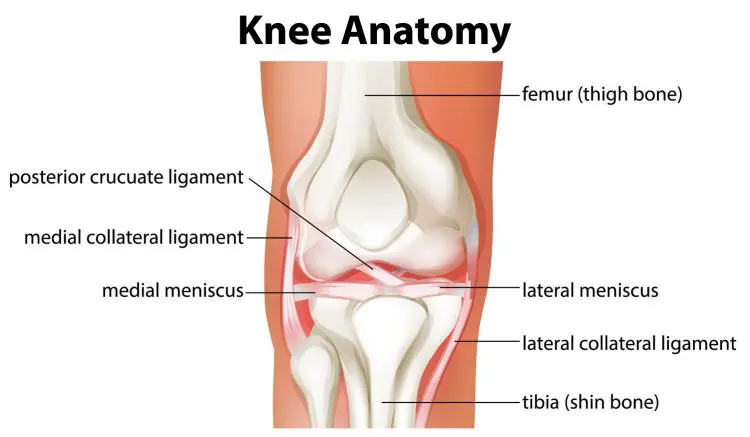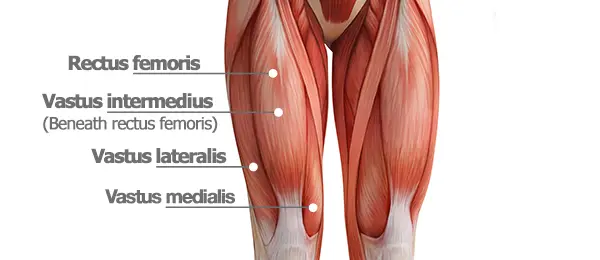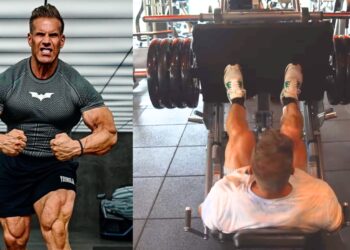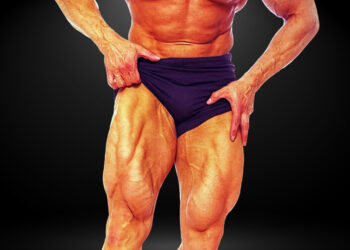I have a torn meniscus in my left knee. This is the cartilaginous “cup” that guides the movements of the knee joint. It probably happened during the lead-up to my last powerlifting competition. All I know is my knee started to hurt, and my doctor sent me for an MRI to confirm his initial diagnosis.
Surgical repair was discussed, but because of the size of the tear and my willingness to try and fix it naturally, we decided that there was no rush for me to go under the knife. Several years later, I’m still going strong, and my knee feels great. I’ve avoided surgery and hope that I can continue to do so.
Contrary to what you might think, this injury hasn’t stopped me from training my legs. In fact, it’s one of the driving forces that keeps me squatting. That’s because strong quads help take pressure off the knee joint, increasing joint stability.
I do have to take care not to overload my knee, and it’ll soon let me know if I’ve pushed too hard. However, continuing to lift helps alleviate discomfort and maintains joint function. Studies show that strengthening the quads can have a positive impact on knee pain and health, even in those with moderate to severe osteoarthritis (1).
Over more than 30 years of personal training, I’ve worked with a lot of exercisers suffering from knee pain. Some of my clients have had total knee replacements, while others wanted to avoid such an invasive surgery. Others just had general knee joint aches and pains, which are typical for active and older exercisers.
In almost every case, exercise helped make things better. That said, it’s important to choose the right exercises, as poor choices can quickly make things worse.
Level Up Your Fitness: Join our 💪 strong community in Fitness Volt Newsletter. Get daily inspiration, expert-backed workouts, nutrition tips, the latest in strength sports, and the support you need to reach your goals. Subscribe for free!
In this article, I share the best quads-strengthening exercises for knee health.
Knee and Quadriceps Anatomy
The knee is a synovial hinge joint comprising the femur or thigh bone and the tibia, which is the larger of the two shin bones. The ends of the femur and tibia are covered in hyaline cartilage, which protects the bones and provides a smooth articular surface for easier movement.

The femur and tibia are held together by ligaments, and the end of the femur sits in a small cartilaginous cup-like structure called the meniscus. The ligaments of the knee joint are:
- Anterior cruciate ligament: Prevents the femur from moving backward on the tibia.
- Posterior cruciate ligament: Prevents the femur from moving forward on the tibia.
- Medial and lateral collateral ligaments: Prevent the femur from moving sideways.
The knee joint is capable of several different articulations or movements. These are:
- Extension – straightening your knee
- Flexion – bending your knee
- Medial rotation – turning your lower leg inward*
- Lateral rotation – turning your lower leg outward*
*These movements are very small and only really occur when your knee is bent.
The movements of the knee are affected by several muscles, including the hamstrings, sartorius, popliteus, and gastrocnemius, all of which flex the knee joint. However, the focus of this article is the quadriceps.
Quadriceps Muscles
There are four muscles that make up the quadriceps (2):
- Rectus femoris – the rectus femoris is the longest of the four quadriceps muscles. It crosses both the hip and knee and affects both these joints.
- Vastus lateralis – this is the outermost quadriceps muscle. It only crosses the knee joint.
- Vastus intermedius – vastus intermedius is your central quadriceps muscle. Like the other vastus muscles, it only affects the knees.
- Vastus medialis – often known as the teardrop muscle, the vastus medialis is located closest to your knee. It’s especially important for the last 30 degrees of knee extension, known as terminal knee extension. It also plays a critical role in joint stability.

All four quadriceps come together at the quadriceps tendon, which envelopes the patella or kneecap, and attaches to the tibial tuberosity, which is a bulge on the front of your shin bone. The tendon transmits the forces generated by the quadriceps muscles, extending your knee.
Common Causes of Knee Pain
Needless to say, the knee is a hardworking and complex joint that is prone to injury, and even healthy knees ache from time to time. Common sources of knee pain include:
- Bursitis – inflammation of the fluid-filled sacs between tendons and bones.
- Iliotibial band syndrome – inflammation of the iliotibial band, which runs down the outside of the knee joint.
- Meniscal tears – damage to the meniscus.
- Osteoarthritis – wear and tear of the articular cartilage within the knee joint.
- Patellar tendonitis – inflammation of the tendon that connects the kneecap to the tibia.
- Patellofemoral pain syndrome – pain behind the patella.
- Strains and sprains – strains affect the muscles, while sprains affect the ligaments.
- Tendinitis – inflamed, swollen tendons.
- Tendinosis – degeneration of the tendons.
Keeping your quads strong can help prevent and alleviate many sources of knee pain (3). However, you should always refer existing knee issues to a qualified medical expert as, in some cases, the wrong type of exercise can make things worse.
Top Quads Strengthening Exercises for Knee Health
It’s beyond the scope of this article to diagnose knee pain. That’s a job for a medical professional. However, in my experience as a personal trainer and sports massage therapist, there are several exercises you can do to strengthen your quads and keep your knees healthy.
For convenience, I’ve listed the following exercises in approximate order of difficulty, starting with the least demanding first. This should make picking the best exercises for your knees and goals more straightforward.
Level Up Your Fitness: Join our 💪 strong community in Fitness Volt Newsletter. Get daily inspiration, expert-backed workouts, nutrition tips, the latest in strength sports, and the support you need to reach your goals. Subscribe for free!
So, if you find an exercise too easy, just move down the list to the next movement. Conversely, if an exercise is too challenging, move up the list to find something more manageable.
Finally, remember it’s a bad idea to self-diagnose or use the internet to identify any kind of injury. Get professional medical advice if you have a previous or existing knee condition, as the wrong exercises could exacerbate the problem.
1. Straight Leg Raises
Straight leg raises are arguably the most knee-friendly way to strengthen your quads. That’s because your knee doesn’t even move! This is a great exercise for rehabbing after a joint injury and is often prescribed by physiotherapists and doctors. I also like this exercise because you can do it anywhere and anytime.
Steps:
- Sit on the floor with your legs extended and your weight supported on your arms.
- Contract the quadriceps on one leg.
- Keeping your leg straight, lift your foot 12-18 inches off the floor.
- Pause for 2-3 seconds, and then lower your leg back down.
- Do the prescribed number of reps on one leg, and then switch sides.
Tips:
- The slower you do this exercise, the more demanding it becomes.
- Wear ankle weights to make it more challenging.
- You can also use a booty band or mini resistance band to increase the difficulty of this exercise.
2. Seated Knee Extensions
This exercise involves a small range of motion, which makes it relatively easy on the knee joint. It emphasizes the vastus medialis, which is most active during the last 30 degrees of knee extension. In studies, this quadriceps muscle is commonly atrophied and weak in patients with knee pain (4). As such, it makes sense that strengthening it is important for knee health.
Steps:
- Sit on the floor with one leg bent and one leg straight. Support your weight in your arms.
- Place a rolled towel behind your extended leg so your knee is slightly bent.
- Push the back of your knee into the rolled towel and extend your leg using your quads.
- Pause for 2-3 seconds, and then lower your foot back to the floor.
- Do the prescribed number of reps on one leg, and then switch sides.
Tips:
- Wear ankle weights to make this exercise more demanding.
- Gradually increase the size of the prop behind your knee to increase your range of motion.
- Pull your toes up toward your shin to maximize quads engagement.
3. Isometric Wall Squats
Isometric exercises involve plenty of muscle tension but no actual joint movement. That means the isometric wall squat is challenging yet knee-friendly. This is an excellent exercise for anyone who wants stronger quads but doesn’t want to punish their knees. It’s suitable for all levels of exerciser, from beginner to advanced.
Steps:
- Stand with your back against a smooth wall. Your feet should be in front of you, about shoulder-to-hip-width apart.
- Slide down the wall until your thighs are roughly parallel to the floor.
- Press your lower back against the wall and hold for the prescribed duration.
- Relax, rest, and repeat for the required number of sets.
Tips:
- Do not hold your breath, as doing so can dangerously elevate your blood pressure.
- Push as hard as you can for a short time, or press less and hold for longer. Both options are effective.
- Adjust the depth of your squat according to the health of your knees. Deeper is not always better.
4. Plank Leg Lifts
Planks are a popular and effective core exercise. However, when you transition from planking with both legs to only using one, it becomes a very effective quads exercise. Where wall squats involve an isometric contraction with your knees bent, plank leg lifts are an isometric exercise with your legs straight. Both exercises deserve a place in your workouts.
Steps:
- Kneel on the floor and rest on your forearms. Walk your feet out and back so your body is straight. Brace your core.
- Without lifting or dropping your hips, raise one leg, pause for 2-3 seconds, and then lower it back down.
- Switch legs and repeat.
- Alternate legs for the required number of reps.
Tips:
- Hold for time instead of doing this exercise for reps if preferred.
- Do this exercise with straight arms – the high plank position.
- Do not hold your breath, as doing so can dangerously elevate your blood pressure.
5. Backward Uphill Walking
While any kind of walking is good for your fitness and health, walking backward may be especially beneficial for your knees. Walking backward uses all your quads, especially that all-important vastus medialis muscle. Backward uphill walking might look a little weird, but it’s good medicine for your quadriceps and knees.
Steps:
- On a slight to moderate incline, carefully walk backward up the hill.
- Make sure you push down through the balls of your feet before transitioning to your heels to maximize quads engagement.
- Periodically look over your shoulder to check that you aren’t heading toward a hazard.
- Continue for the required distance or duration.
Tips:
- You can simulate this exercise on a treadmill. Turn the motor off and use your muscles to push the treadmill belt along. Keep your butt against the console for balance:
6. Backward Sled Drag
Most people associate weighted sleds with conditioning and fat loss. However, they’re also an excellent strength and muscle-building tool. Dragging a sled backward provides an intense but joint-friendly quads workout. Also, with no eccentric or lowering phase, they generally cause minimal post-workout muscle soreness.
Steps:
- Load your sled and stand facing it. Hold the tow strap, pull your shoulders back, and brace your core.
- Keeping your arms straight, walk backward for the prescribed distance.
- Push down through the balls of your feet before transitioning to your heels to maximize quads engagement.
- Attach the tow strap to your waist to avoid having to use your arms and focus more on your quads.
- Don’t be afraid to load up your sled and go heavy. This is an excellent exercise for building muscle strength and size while being kind to your knees.
- Turn around and walk forward to work your glutes and hamstrings for a complete leg workout in two moves.
7. Box Squats
Squats are one of the best exercises you can do for your quads. However, for some people, deep squats can cause knee pain. Box squats are an easy way to control squat depth and prevent you from descending too far. As a trainer, I’ve found box squats to be one of the most knee-friendly squat variations.
Steps:
- Stand with your back to a knee-high bench. Your feet should be shoulder-width apart, toes turned slightly outward. Brace your core and pull your shoulders down and back.
- Bend your legs, push your hips back, and descend until your butt lightly touches the bench.
- Pause on the bench but do not relax. Stay tight!
- Drive your feet into the floor and stand back up.
- Reset your core and repeat.
Tips:
- You can do this exercise with a barbell, dumbbells, or kettlebell for added resistance if needed.
- Start with a high bench, and lower it as your knee health and flexibility improve.
- Experiment with your stance width to determine what works best and is most comfortable.
8. Step-Ups
Most quads exercises are bilateral, meaning they work both legs at once. This is not a bad thing, but nor is it how you use your legs work most of the time. The majority of human movements happen one leg at a time, e.g., walking, running, and jumping. Step-ups are one of the most knee-friendly unilateral quads exercises around. They’re also a great movement for home exercisers who may not have access to a squat rack.
Steps:
- Stand facing a stable, sturdy, knee-high platform.
- Bend one leg and place your foot on the top of your step.
- Driving down through your foot, step up and onto the platform.
- Step down with the same leg and repeat.
- Continue for the desired number of reps, rest a moment if necessary, and then do the same number on the other side.
Tips:
- Hold weights or use a weighted vest for a more demanding workout.
- Use a higher step to make this exercise harder, or a lower step to make it easier.
- Use an alternating leg action if you prefer.
9. Deadlifts
Most people view deadlifts as a back and posterior chain exercise. However, they’re also a good quads exercise that puts relatively little stress on your knees. That’s because the range of motion isn’t very big. This is an excellent exercise for overloading your quads without punishing your knees.
Steps:
- Place a loaded barbell on the floor. Ideally, it should be about mid-shin height.
- Stand with your toes under the bar, feet hip-width apart.
- Squat down and hold the bar with an overhand, shoulder-width grip.
- Straighten your arms, drop your chest, brace your core, and pull your shoulders down and back.
- Drive your feet into the floor and stand up, taking care not to round your back or let your hips rise faster than your shoulders.
- Lower the weight back to the floor, reset your core and grip, and repeat.
Tips:
- Use a trap bar instead of a barbell for a more lower-back-friendly workout.
- Use gym chalk or lifting straps for a more secure grip on the bar.
- Wear zero-drop (flat) shoes or go barefoot for a more stable stance and to avoid being pulled forward during deadlifts.
10. Quadriceps Foam Rolling
It isn’t just weak quadriceps that can affect knee health; tight, knotted muscles can, too. Stretching your quads will undoubtedly help, but very tight muscles need even more care and attention. Foam rolling helps release the fascia, which is a layer of connective tissue around and between your muscles. While foam rolling can be uncomfortable, I guarantee your quads will feel amazing afterward!
Steps:
- Lie face down on the floor and place your foam roller beneath your thighs. Rest on your forearms.
- Move up and down the roller, pausing on any “hot spots” or knots. Turn your thighs in and out to ensure you hit all of the quads.
- Continue for 60 seconds or so or until you feel your muscles starting to relax.
- Periodically bend your knees to lengthen your quads and hit the fibers from a different angle.
Tips:
- Don’t foam roll too hard, too soon. Otherwise, you may end up bruising yourself.
- Progress to rolling one leg at a time so you can put more weight on the target muscles.
- Progress to a firmer roller as you get used to this type of soft tissue treatment.
Closing Thoughts
According to a study published on PubMed in 2018, as many as 25% of adults suffer from chronic knee pain (5). This is an increase of nearly 65% in the last two decades. While some types of knee pain are unavoidable, in many instances, exercise makes the pain more manageable, improving joint function and quality of life.
Despite this, many knee pain sufferers avoid working out because they believe it’ll make things worse. Squats often get the blame for knee pain, which is a hangover from a study done way back in the 1960s that suggested deep squats were dangerous. Needless to say, most studies now refute this.
The reality is that weak quads and being overweight are worse for your knees than working out. Exercise is the perfect prescription for knee pain and better joint health.
You just need the right movements.
In my experience, and that of my clients, working out makes knee pain much more manageable. In fact, the only time I think about my knees is when I don’t exercise, and they start to stiffen up.
So, use the movements in this guide to improve the strength of your quads for healthier, more stable knees. However, for existing knee pain, work with a medical professional to ensure that you don’t do anything that makes your joints worse.
References:
- Imoto AM, Peccin MS, Trevisani VF. Quadriceps strengthening exercises are effective in improving pain, function, and quality of life in patients with osteoarthritis of the knee. Acta Ortop Bras. 2012;20(3):174-9. doi: 10.1590/S1413-78522012000300008. PMID: 24453599; PMCID: PMC3718434.
- Bordoni B, Varacallo M. Anatomy, Bony Pelvis, and Lower Limb: Thigh Quadriceps Muscle. [Updated 2023 May 8]. In: StatPearls [Internet]. Treasure Island (FL): StatPearls Publishing; 2023 Jan-. Available from: https://www.ncbi.nlm.nih.gov/books/NBK513334/
- Segal NA, Glass NA. Is quadriceps muscle weakness a risk factor for incident or progressive knee osteoarthritis? Phys Sportsmed. 2011 Nov;39(4):44-50. doi: 10.3810/psm.2011.11.1938. PMID: 22293767.
- Lotfi H, Moghadam AN, Shati M. Electromyography Activity of Vastus Medialis Obliquus and Vastus Lateralis Muscles During Lower Limb Proprioceptive Neuromuscular Facilitation Patterns in Individuals with and without Patellofemoral Pain Syndrome. Phys Ther Res. 2021 Jul 30;24(3):218-224. doi: 10.1298/ptr.E10094. PMID: 35036255; PMCID: PMC8752958.
- Bunt CW, Jonas CE, Chang JG. Knee Pain in Adults and Adolescents: The Initial Evaluation. Am Fam Physician. 2018 Nov 1;98(9):576-585. PMID: 30325638.








